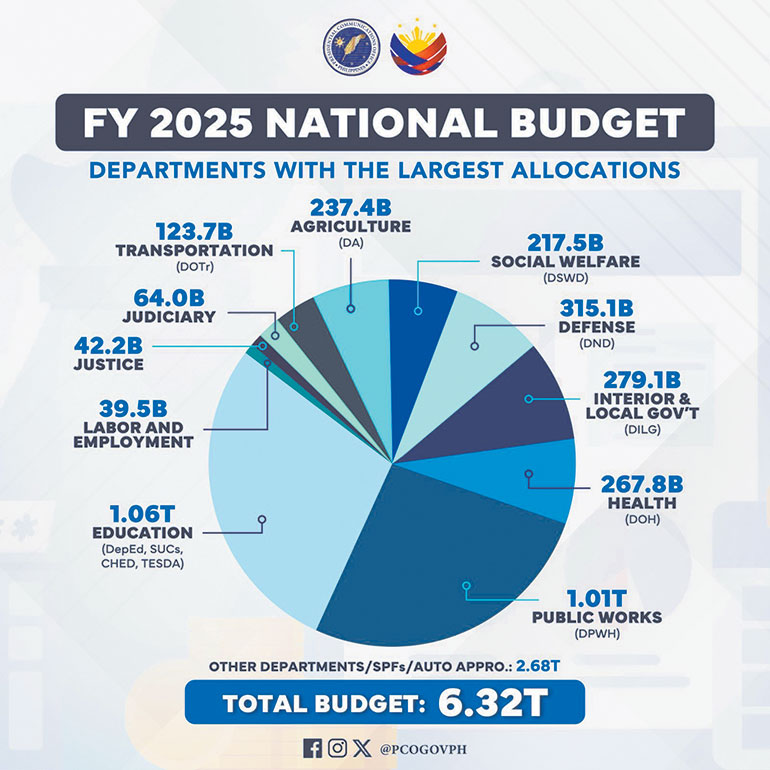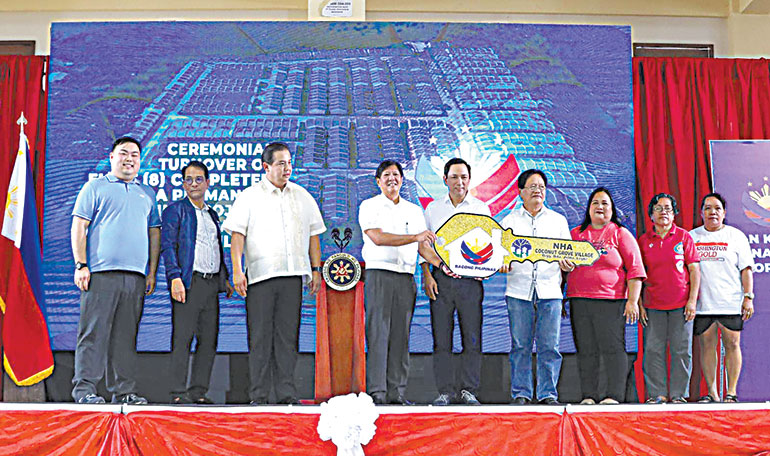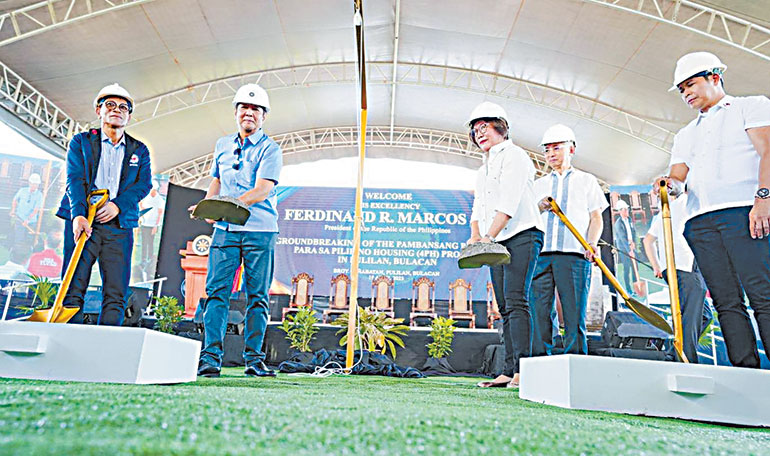Planning a better 2025 for the Philippine economy

As the brand new year creates a fresh start and new opportunities, the Philippine government’s goal remains steadfast: sustaining economic momentum and enriching the lives of millions of Filipinos.
Bringing this resolution to life, the Marcos administration is laying the groundwork for the country’s growth through the national budget for 2025, which amounts to P6.326 trillion. This budget is designed to support programs, projects, and various sectors that align with the nation’s journey towards achieving its development goals.
President Ferdinand “Bongbong” R. Marcos, Jr. announced that the national budget for 2025 is to ensure that all government programs effectively support its citizens. He subsequently signed the national budget into law, emphasizing its crucial role in maintaining government operations and addressing the nation’s most pressing needs.
With strong vision and determination to achieve a stable economy, the administration set forth its journey in building the Bagong Pilipinas (New Philippines) agenda. This initiative requires a multifaceted approach, with the implementation of the national budget plan serving as a critical tool to sustain the economic momentum.
One key focus of this agenda is to ramp up efforts of social services, such as the Department of Social Welfare and Development’s (DSWD) Ayuda sa Kapos ang Kita (AKAP) program, which provides support to low-income families in the Philippines. This initiative aims to help families cope with rising prices and basic necessities. Currently, the program has been implemented in several provinces across the Central Luzon region. It is a collaborative effort involving the DSWD, the Department of Labor and Employment (DoLE), the National Economic Development Authority (NEDA), and the local government units (LGUs).
“This way we ensure that its implementation will be strategic leading to the long-term improvement of the lives of qualified beneficiaries, while guarding against misuse, and duplication, and fragmented benefits,” Mr. Marcos said.

Infrastructure projects
Recognizing infrastructure as a strong foundation for a thriving economy, the administration also expressed its commitment this year to maximizing opportunities by funding more transformative projects and development.
One key aspect discussed during a meeting on the 2025 agenda was the strong support of the administration for the Department of Public Works and Highways (DPWH) and its projects this year. This agency is expected to build more and better key infrastructure that will drive economic growth and improve connectivity. According to Mr. Marcos, prioritizing such projects is essential, given the country’s growing need for projects that can improve people’s lives.
Echoing the same sentiment, DPWH has pledged to work diligently on building infrastructure projects that support the country’s socioeconomic agenda. These efforts will be especially vital in driving significant transformations in the country and fostering national progress.
“It is therefore our responsibility to ensure that these funds are used wisely and efficiently as well as professionally in the most transparent manner, proving ourselves, deserving of the trust placed on us. We are committed to making every cent of their contributions worth by delivering quality infrastructure that drives the national progress,” DPWH Secretary Manuel E. Bonoan was quoted as saying during a press briefing.
“Rest-assured that the Department of Public Works and Highways will continue to work diligently in support of the Bagong Pilipinas agenda advancing infrastructure that uplifts the lives of our fellow Filipinos,” he added.
Following this, the administration is prioritizing significant infrastructure projects this year, starting with the rehabilitation of the Epifanio de los Santos Avenue (EDSA), one of the longest and busiest roads in the country. For years, EDSA has been central to the country’s transportation network, connecting key cities and serving as a hub for economic activities in Metro Manila. However, it has faced persistent issues, including overpopulation, severed traffic congestion, and poor infrastructure. The rehabilitation project, as Mr. Bonoan emphasized, aims to address these challenges and improve transportation for millions of Filipinos.
“The President wants to improve the riding quality of EDSA. We will rehabilitate the entire EDSA starting 2025,” he said in a recent media interview. “Right now, when driving through EDSA, sometimes it’s difficult to text because of its bumpy roads. (Kasi sa ngayon dumaan ka sa EDSA kung minsan nahihirapan kang mag-text sa kakakalbog ng sasakyan.) So, I think it’s about time that we need to rehabilitate EDSA once and for all.”
The Bataan-Cavite Interlink Bridge is another massive infrastructure to keep an eye out this year. This 32-kilometer bridge will connect the Southern Luzon to Central Luzon, stretching from Manila Bay to Bataan and Cavite. Upon completion, it is expected to ease traffic congestion by rerouting vehicles and reducing travel time from Manila from four hours to 40 minutes.
Considered as a game-changing infrastructure project, the bridge poised to become the second longest bay road in the world. Beyond improving transportation, it is anticipated to bring more economic growth to the area. This project is expected to be completed within Mr. Marcos’s term.
Reliable, Climate-Resilient Housing

The government has kickstarted its Pambansang Pabahay para sa Pilipino (4PH) Program, which seeks to address the Philippines’ housing backlog through vertical housing in partnership with government financial institutions and the private sector. Back in April, the government spearheaded the groundbreaking ceremony for the 4PH Housing Project in San Rafael and Pulilan in Bulacan. More recently, in December, the administration’s awarded notices of approval to five overseas Filipino workers (OFWs) for housing units in Palayan City.
There are reportedly 56 ongoing projects under 4PH in various phases of construction and development across the country. According to Department of Human Settlements and Urban Development (DHSUD) Secretary Jose Rizalino Acuzar, the 4PH projects are beginning to bring initial results as turnover of 4PH units to beneficiaries are expected in the coming weeks.

On top of this, the Yolanda Permanent Housing Program (YPHP), which awards developed lots with housing units at no cost to qualified Yolanda survivor-family beneficiaries, has also sustained its progress as eight completed permanent housing projects were turned over earlier in January. A total of 3,517 housing units were provided for the typhoon affected areas, including Leyte, Samar, and Biliran.
“It has been more than a decade since the world witnessed the strength and unity displayed by the Filipino people. Despite the challenges brought by natural disasters, we have shown courage, faith, and dedication to overcome such challenges. We now present the more than 3,500 houses built, which are part of the projects that will be completed in Leyte, Samar, and Biliran,” Mr. Marcos said in Filipino during the ceremony.
“We wish to see you succeed not only for yourselves but for the future of our next generations,” he continued. “Together, let’s appreciate these homes that will serve as the foundation of a stronger community and a brighter future. With our continued cooperation and fellowship, I believe we can achieve a stable, progressive, and prosperous new Philippines.” — Angela Kiara S. Brillantes


